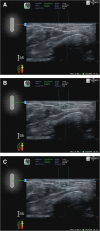A novel electromagnetic guidance ultrasound system on radial artery cannulation: a prospective randomized controlled trial
- PMID: 33461484
- PMCID: PMC7812638
- DOI: 10.1186/s12871-021-01244-6
A novel electromagnetic guidance ultrasound system on radial artery cannulation: a prospective randomized controlled trial
Abstract
Background: Radial artery cannulation can cause complications such as haematoma formation or thrombosis due to its small diameter. Recently, a novel ultrasound device equipped with an electromagnetic guidance system was introduced, showing the path and alignment of the needle during the procedure. The aim of this study was to investigate the effects of this novel system on both success and complication rates during radial artery cannulation under ultrasound guidance.
Methods: In this randomized controlled trial, 76 adults scheduled for neurosurgery requiring radial artery cannulation were recruited. In group E (n = 38), radial artery cannulation was performed using the electromagnetic guidance ultrasound system, whereas in group C (n = 38), the procedure was performed using conventional ultrasound guidance. The success rates of cannulation on the first attempt, cannulation times, number of attempts, and incidence of complications were compared between the two groups.
Results: There was a significant difference in the success rates on the first attempt between the two groups (group C = 78.9% vs. group E = 94.7%, P = 0.042). Incidences of posterior wall puncture and haematoma formation (group C = 8 vs. group E = 1; P = 0.028) were significantly lower in group E than in group C. The median cannulation time for successful attempts was comparable between groups.
Conclusions: Use of the novel electromagnetic guidance system resulted in a better success rate on the first attempt and a lower incidence of complications during radial artery cannulation.
Trial registration: This study was registered at http://cris.nih.go.kr (registration number: KCT0002476 ).
Keywords: Cannulation; Catheter; Electromagnetic fields; Radial artery; Ultrasonography.
Conflict of interest statement
The authors declare that they have no competing interests.
Figures

References
-
- Michard F, Boussat S, Chemla D, Anguel N, Mercat A, Lecarpentier Y, Richard C, Pinsky MR, Teboul J. Relation between respiratory changes in arterial pulse pressure and fluid responsiveness in septic patients with acute circulatory failure. Am J Respir Crit Care Med. 2000;162(1):134–138. doi: 10.1164/ajrccm.162.1.9903035. - DOI - PubMed
Publication types
MeSH terms
Associated data
LinkOut - more resources
Full Text Sources
Other Literature Sources

